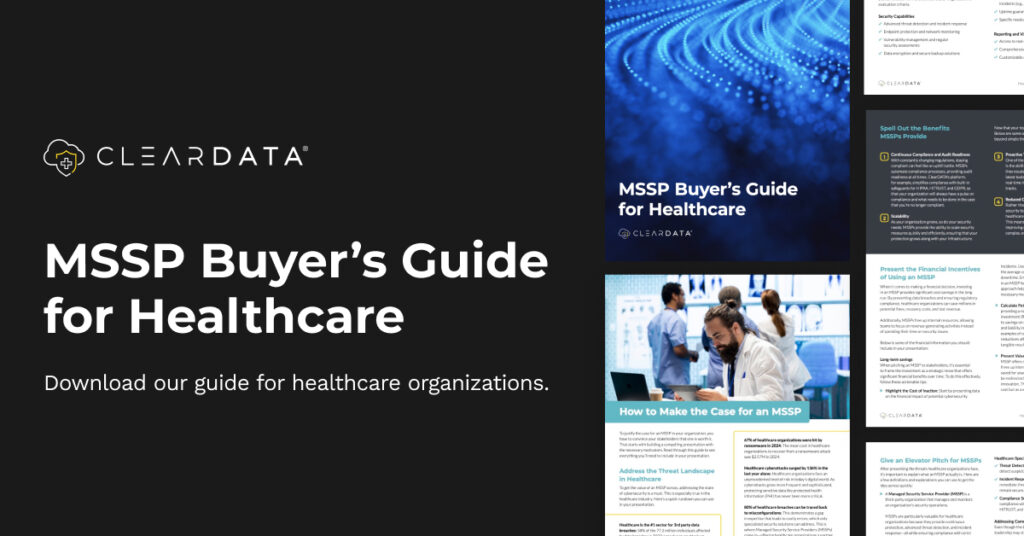Your Healthcare Cyber Resiliency Roadmap for 2025
Cyber threats in the healthcare industry continue to escalate, with 2024 marking a year of extraordinary challenges. High-profile ransomware attacks and breaches exposed vulnerabilities in healthcare systems, putting the sensitive data of millions at risk and disrupting critical operations. This growing threat landscape highlights the critical importance of healthcare cyber resiliency in 2025 and beyond.
Healthcare cyber resiliency refers to an organization’s ability to prepare for, respond to, and recover from cyber threats while maintaining critical operations and protecting sensitive data, such as Protected Health Information (PHI). It combines robust cybersecurity measures, operational planning, and continuous adaptation to ensure uninterrupted patient care and regulatory compliance. Tackle cyber resiliency head on with our roadmap for 2025.

Operational And Technological Challenges in Achieving Healthcare Cyber Resiliency
Healthcare organizations face a perfect storm of challenges in achieving cyber resiliency including operational, technological and regulatory hurdles.
Operational Challenges in Healthcare Cyber Resiliency
Legacy Systems: Many healthcare organizations rely on outdated systems that are difficult to patch or integrate with modern cybersecurity solutions. These systems are often critical to daily operations, making downtime for updates unfeasible. For example, outdated EHR platforms may lack encryption or multi-factor authentication, creating vulnerabilities.
Resource Constraints: Tight budgets often prioritize patient care over cybersecurity investments. Small to mid-sized healthcare providers struggle to allocate funds for robust IT teams or state-of-the-art security solutions. Limited IT staff often lack specialized training in cyber risk management, leaving organizations underprepared for sophisticated attacks.
Complex Ecosystem: Hospitals and clinics are complex environments with interconnected systems, from IoT-enabled medical devices to third-party vendor solutions. Each connection increases the attack surface. For example, compromised medical devices like infusion pumps can serve as entry points for attackers.
Human Factors: Phishing remains a top threat due to insufficient employee training. Healthcare workers prioritize patient care, which often leads to lapses in security protocols, like weak passwords or sharing credentials.
Technology Challenges
IoT and Connected Devices: The increase in IoT-enabled devices, such as smart monitors and imaging systems, introduces vulnerabilities, since many devices were not designed with security in mind. Updating or patching these devices is difficult because downtime can directly impact patient care.
Data Volume and Sensitivity: Healthcare organizations store vast amounts of sensitive data, such as PHI (Protected Health Information). The value of PHI on the black market makes healthcare a prime target for ransomware attacks. Ensuring secure data exchange across providers and payers adds further complexity.
Cloud Adoption: While cloud solutions offer scalability, they also introduce risks related to misconfigurations and inadequate access controls. Organizations transitioning to hybrid models (on-prem and cloud) often lack comprehensive visibility and security controls across their environments.
Regulatory Challenges
Compliance Burden: Regulations like HIPAA, GDPR, and HITRUST require stringent data protection measures, but meeting these standards can be time-consuming and expensive. Audits and compliance reporting divert resources from proactive cybersecurity measures. Cybersecurity best practices and regulatory requirements frequently evolve, requiring organizations to continually update policies, processes, and technologies to stay compliant. Failure to comply can result in heavy fines, legal liability, and reputational damage.
Vendor Management: Third-party vendors handling PHI must also comply with regulations. Ensuring vendor adherence to security standards adds another layer of complexity. Many healthcare breaches originate from third-party vulnerabilities, such as compromised billing or scheduling systems.
How to Navigate Privacy and Regulatory Changes in 2025
The healthcare sector faces a pivotal moment in 2025 as new regulations and heightened scrutiny redefine the landscape of data privacy and security. Healthcare organizations must adapt quickly, incorporating robust compliance strategies into their operational frameworks. The upcoming changes prioritize patient privacy while imposing stricter obligations on entities handling health-related data. Here’s a breakdown of the key regulatory developments and their implications:
Proposed Updates to the HIPAA Security Rule
The U.S. Department of Health and Human Services (HHS) Office for Civil Rights plans to propose significant updates to the HIPAA Security Rule. Originally finalized over 20 years ago, these updates are expected to strengthen security obligations for organizations managing protected health information (PHI).
Impact: Organizations should reassess their current HIPAA compliance programs, focusing on modernizing their IT infrastructure and aligning it with anticipated guidelines. Failure to meet these new standards could result in increased penalties and reputational harm.
State-Level Consumer Health Data Laws
The state regulatory framework continues to evolve, with multiple states poised to enact consumer health privacy laws. For example:
-
- Iowa Consumer Data Protection Act and Nebraska Data Privacy Act come into effect in January 2025.
-
- New Jersey’s Data Privacy Act follows shortly after, with Maryland’s Online Data Protection Act launching later in the year.
-
- These laws bring diverse requirements, such as mandating privacy impact assessments, minimizing exemptions for regulated entities, and implementing tighter controls on data sharing.
Additionally, some states, like Michigan and Washington, are advancing measures to regulate reproductive health data and genetic information. The increased patchwork of state laws creates a complex compliance environment for healthcare organizations operating across jurisdictions.
Impact: Healthcare providers must closely monitor state-level requirements and implement tailored compliance mechanisms. Developing dynamic privacy programs that address overlapping yet distinct regulations will be crucial for operational continuity.
Heightened FTC Oversight and Enforcement
The Federal Trade Commission (FTC) remains a formidable force in scrutinizing the use and disclosure of health-related information. Digital health platforms and healthcare entities must brace for intensified enforcement under the newly expanded Health Breach Notification Rule. This follows years of action against companies exploiting sensitive health data for advertising or profit-driven purposes.
Impact: Organizations need to conduct comprehensive audits of their data management and marketing processes. Reviewing policies for transparency, limiting data collection, and ensuring robust security measures will help mitigate potential enforcement actions.

Top Healthcare Cyber Resiliency Strategies for 2025
Healthcare leaders must prioritize strategies that ensure their organizations are prepared for emerging threats. Consider integrating the following measures into your 2025 roadmap:
Implement a Comprehensive Cybersecurity Framework: Adopting frameworks like the HHS Cybersecurity Performance Goals provides a clear structure for improving your security posture. These frameworks emphasize best practices critical to thwarting common attack vectors.
Strengthen Third-Party Risk Management: Healthcare organizations rely heavily on third-party vendors, from supply chain partners to software providers. Evaluate and manage vendor risks continuously to prevent vulnerabilities that attackers could exploit.
Plan for Clinical Continuity: Proactively develop contingency plans to maintain patient care during extended outages caused by cyber incidents. Include measures for alternate data access, manual processes, and communication protocols.
Focus on Digital Transformation: Modernizing IT infrastructure through secure cloud adoption, AI-driven threat detection, and zero-trust architectures will enhance both security and operational efficiency
Adopt Advanced AI-Driven Threat Detection: Leverage AI and machine learning tools to detect and respond to cyber threats in real-time. These tools can analyze vast amounts of data quickly, identifying anomalies and potential breaches before they escalate. Regularly update AI models to stay ahead of evolving attack methods.
Implement Decentralized Data Storage: Move towards decentralized or blockchain-based data storage systems to minimize the risk of large-scale data breaches. This approach makes it significantly harder for attackers to access sensitive patient or organizational information in one central location.
Enhance Zero-Trust Security Practices: Strengthen zero-trust architectures by enforcing strict identity verification for every user, device, and application trying to access your network. Incorporate continuous monitoring and adaptive access controls to ensure only the right people have access at the right time.
Prioritize Cybersecurity Incident Simulation: Run regular, realistic simulation exercises to test your organization’s response to different cyberattack scenarios. These drills should involve all stakeholders, including IT teams, executives, and frontline workers, to ensure preparedness across the board.
Create a Cyber Crisis Response Ecosystem: Build partnerships within the healthcare and cybersecurity industries to share threat intelligence and best practices. Collaborative ecosystems enable rapid information exchange, improving the collective ability to respond to emerging threats.
Integrate Threat Intelligence Platforms: Incorporate threat intelligence platforms to gain actionable insights into global cyberattack trends and vulnerabilities. These platforms can provide predictive analysis, allowing organizations to address potential threats before they materialize.
Utilize Biometric and Behavioral Authentication: Replace traditional passwords with multi-factor authentication methods that include biometrics or behavioral patterns. These advanced methods make it significantly harder for attackers to compromise user accounts.
Track and Update Cybersecurity Strategies Based on Regulatory and Compliance Implications: Prepare for potentially stricter regulations by conducting privacy impact assessments, enhancing vendor management, updating privacy notices, and investing in advanced cybersecurity measures.
Integrate Proactive IoT Security Protocols: With the rise of Internet-of-Things (IoT) devices in healthcare, implement robust protocols to secure connected devices. Regularly update firmware, segment IoT networks, and monitor these devices for unusual activity.
Create a Cyber Crisis Response Ecosystem: Build partnerships within the healthcare and cybersecurity industries to share threat intelligence and best practices. Collaborative ecosystems enable rapid information exchange, improving the collective ability to respond to emerging threats.
Why Cyber Resiliency is Non-Negotiable
The cost of cyberattacks—financial, operational, and reputational—continues to rise. But beyond the numbers lies the reality that failing to protect systems and data can put lives at risk. Cyber resiliency enables organizations to adapt and recover swiftly, maintaining trust and care standards in the face of adversity.
Prepare your organization for the challenges of 2025 by implementing a robust cyber resiliency strategy. Our team of experts specializes in healthcare cloud security and advanced threat detection technologies.
Talk to a healthcare cloud expert today to secure your operations and strengthen your defense against cyber threats. today to secure your operations and strengthen your defense against cyber threats.
FAQ
What is cyber resilience?
Cyber resilience refers to an organization’s ability to anticipate, withstand, recover from, and adapt to cyberattacks and other disruptions. It goes beyond just preventing attacks, focusing instead on minimizing the impact of a breach and maintaining operations during and after an incident.
How does cyber resilience differ from cybersecurity?
While cybersecurity focuses on protecting systems and data from threats, cyber resilience takes a broader approach. It emphasizes not only preventing attacks but also adapting, responding, and recovering from them to ensure continued operations and minimal impact on critical services.
Why is cyber resilience important for healthcare?
Cyber resilience is critical in healthcare because patient safety and care depend on the availability and integrity of systems and data. A cyberattack can disrupt care delivery, compromise sensitive patient information, and, in worst-case scenarios, jeopardize lives. Cyber resilience ensures continuity of care and safeguards trust.



